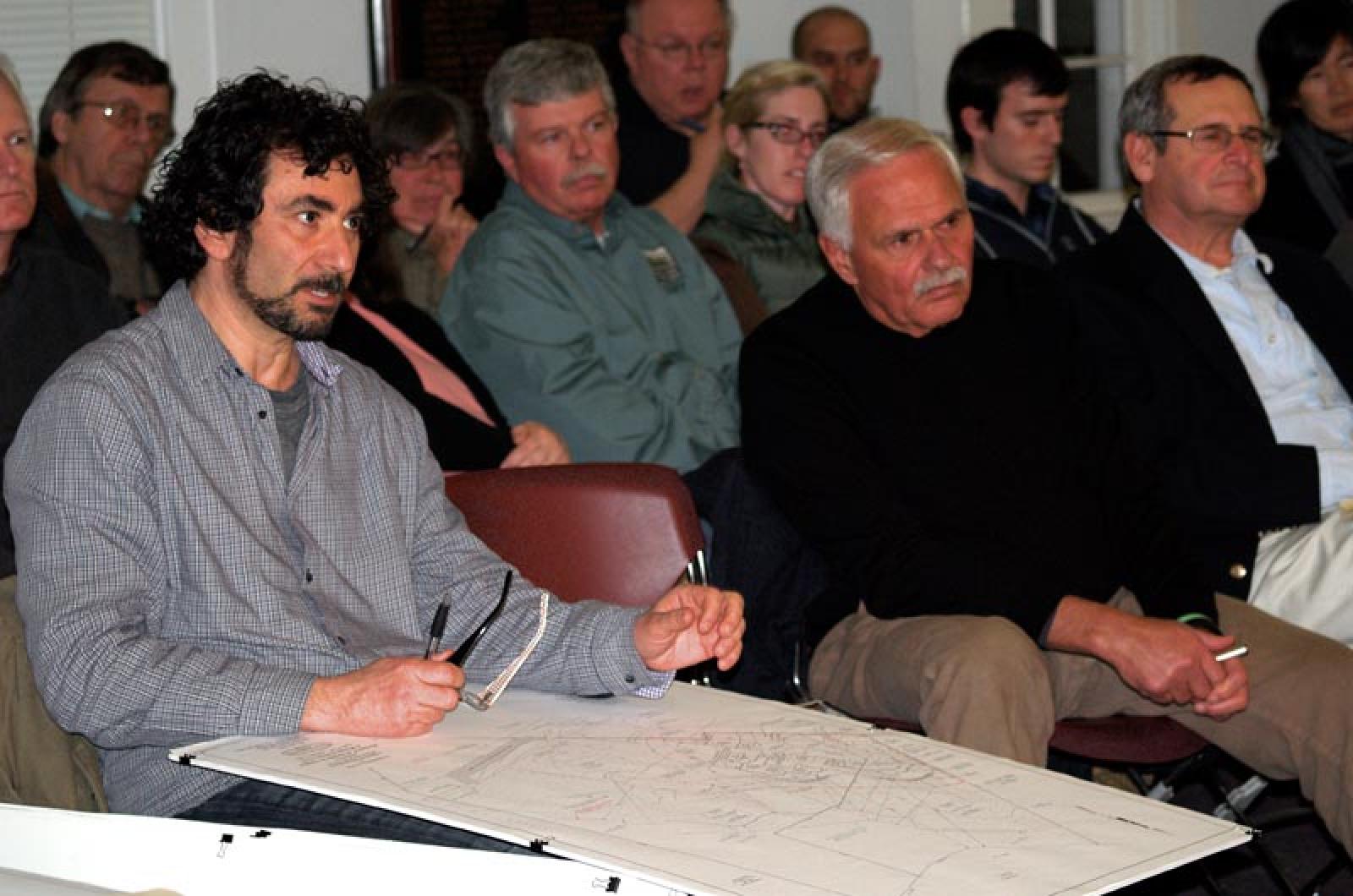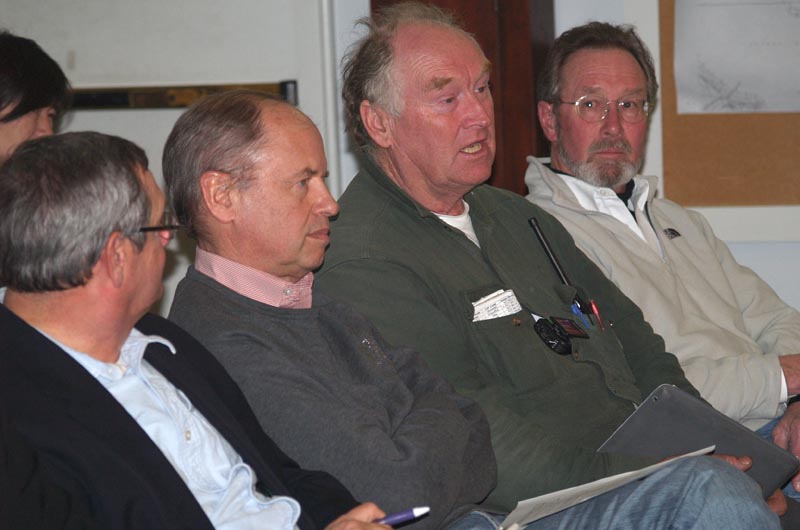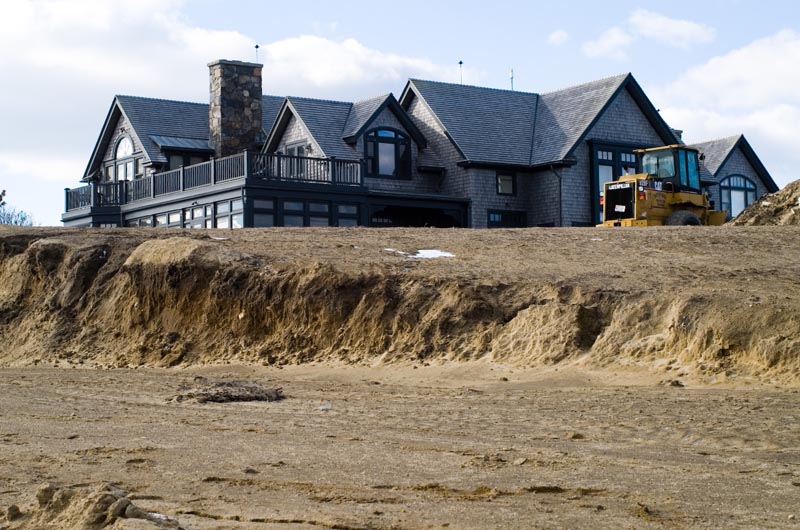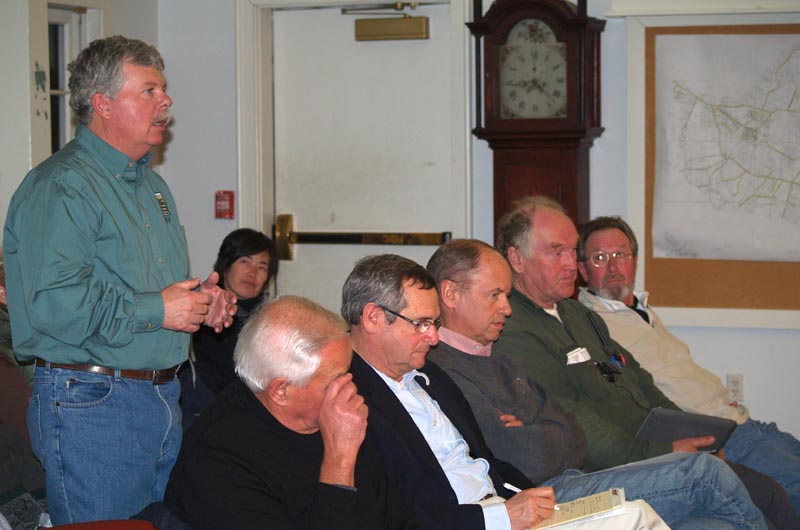Plans to move a Chappaquiddick house threatened by rapid coastal erosion took a step forward Tuesday when the Edgartown planning board approved a special permit for the first stage of the house move.
The board got its first look Tuesday at plans to relocate an 8,800-square-foot house at Wasque Point owned by Richard and Jennifer Schifter, as well as a guest house and garage. The Schifter property has been threatened by rapid erosion over the last year; the coastal bluff is now 50 feet away from a stone pool enclosure.
The house, at the very tip of Wasque Point, is surrounded by Trustees of Reservations property.
To make way for the house relocation, the Schifters purchased a neighboring house and property from the Leland family in December. An application also was filed to move that house to make room for the relocated main house. After about two hours of discussion Tuesday, the planning board approved the Leland house move as well as a property line adjustment. They asked engineer George Sourati, who is working on behalf of the Schifters, for more information before approving the rest of the project.
Mr. Schifter attended the meeting, along with representatives from International Chimney Corporation, the company that will execute the house move. Company president Richard T. Lohr detailed the moving process to the board. He explained that after excavation it will take about three or four days to actually move the structure, with jacks and beams providing support and the structure then jacked up and loaded onto about 20 small dollies, each the size of a small Volkswagen.
Once the house is moved, the closest structure, a retaining wall, will be 275 feet away from the bluff.
Planning board member Robert Sparks advocated for the board to act with dispatch. “I think this whole issue is time sensitive,” he said. “I recommend the town immediately approve phase one and get started moving the Leland property.” He later added: “They have to sit there and watch the sandbank erode on a daily basis.”
But a number of concerns were raised about the project, including its potential impacts on Chappaquiddick, a rural outpost with a single, narrow paved road, a fragile water table and about 100 year-round residents. The sole access to the island is via a three-car ferry.
John Ramsey, a senior coastal engineer with Applied Coastal Research and Engineering in Mashpee who was hired by the planning board as an independent consultant to evaluate the project, said his concerns were centered more on the moving of materials than the moving of the house. “We’re looking at the order of a thousand trips [with trucks carrying soil and other materials],” he said. “We are looking at a major traffic issue . . . We are talking about two miles away [to an] offsite area, those two miles of road that are going to be beat up pretty good.”
Mr. Sourati told the Gazette the next day that soil removed from the excavation process will be stored at two sites on Chappaquiddick. Gerald Jeffers and the Martha’s Vineyard Land Bank have agreed to allow soil storage on their properties, he said. Most of the soil would go back to the Schifter property to fill in the excavated sites, he said.
But Mr. Ramsey had concerns about that too. He said it was important to make sure the replaced soil is packed the same way it was before, “so it if ever becomes the face of the coastal bank it won’t erode any faster.” There is specialized equipment available for compacting soil, Mr. Ramsey said.
Mr. Ramsey also asked if the main house could be moved without excavating the basement, which he said would be a difficult project that would disturb more soil. As plans stand now, the house would be moved with the basement intact.
Mr. Lohr said because the basement is “fairly comprehensive,” with a large mechanical room in addition to the theatre and bowling alley, it would be difficult to remove separately, and the equipment for relocation would be roughly the same either way.
“It’s a very difficult situation, obviously,” Mr. Ramsey said when the board asked him for this thoughts. He noted that if the house fell, it “could be very damaging to the downward beaches. I think moving the house back is something that’s a wise move.”
“I’ve never seen a house of this scale with this size foundation moved, so this is new to me,” he added.
Chappaquiddick resident Woody Filley said he was not opposed to the house move, but he questioned the impacts on Chappy. “I just hope that what we come up with is the best solution that doesn’t create new benchmarks and new standards that we are going to regret in the future,” he said.
Chris Kennedy, the Vineyard superintendent for The Trustees of Reservations, which owns hundreds of acres of conservation land surrounding the Schifter property, raised a whole different set of concerns about the potential for the relocated Schifter home to impede on the viewshed at Wasque, an unspoiled landscape of open moors that run to the sea. “We are generally supportive of this effort to move the house,” Mr. Kennedy said. “Obviously the Trustees clearly don’t want to see any of this structure down on the beach.” But he added: “The beautiful thing about Wasque is when you enter that property you don’t see house after house after house. It’s truly an experience. From the Trustees perspective we would very much hope that at the end of this whole process that the public is not subjected to looking at the top of roofs.”
Mr. Kennedy said up to 20,000 people visit Wasque Reservation in the summer months, and he asked how public safety would be safeguarded with the construction process. One additional issue also came up: whether the relocation project needs to go before the Martha’s Vineyard Commission. Commission staff planner Bill Veno, who attended the meeting, said the commission’s compliance committee discussed the issue and determined it did not, but he said that was before the lot line adjustment. Because part of the Leland property was a development of regional impact, he said, the existing plan might be a modification that needs to go before the commission. The planning board decided not to refer it there.
The planning board continued the public hearing about moving the main house to their next meeting on March 19. Mr. Sourati said the project needs separate approval from the conservation commission after the planning board, and then they will have to wait for the appeal period before getting the permit.
“We’re not moving as fast as the ocean but we’re trying to move,” Mr. Sparks told Mr. Schifter.
Emergency efforts to save the house began in the fall, when the conservation commission approved the installation of a coir envelope system, with coconut fiber envelopes filled with sand stacked on the coastal bank to stem the erosion. Planning board member Alan Wilson briefly questioned whether the house still needs to be moved with the coir envelope system in place, but the system is not meant to be permanent.
While most of the meeting revolved around technical questions and serious decisions, there were moments of levity. One came from Mr. Wilson, who is a Chappaquiddick resident, who stopped to ask an important question after a glance at the clock.
“Peter, are you going to run the ferry to take us home,” he asked Chappy ferry captain Peter Wells, who was in the audience.
Mr. Wells responded in the affirmative, and the meeting went on.










Comments (1)
Comments
Comment policy »